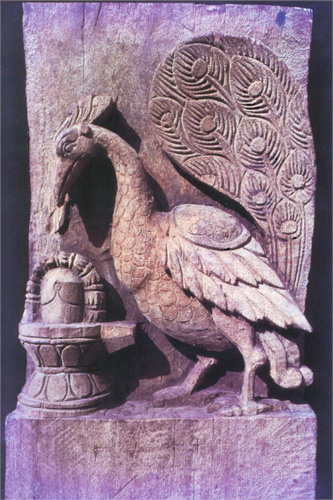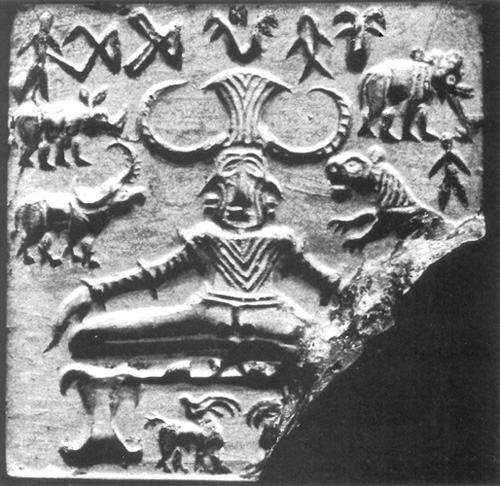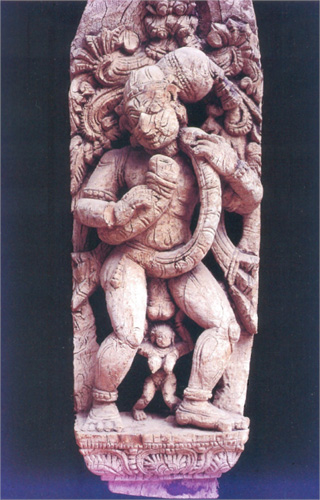5
THE LORD OF THE ANIMALS
The god whose emblem is the phallus first appears as a shepherd god, the friend of beasts, wandering in the forest with his penis erect and fascinating all creatures. The Hindu Purānas have preserved numerous descriptions of this strange and sacred character and of his adventures. This shepherd god who lives in the forest is to be found in all cultures, whether as Egypt's Min, Amon, Ra, Osiris, or even Pan, Priapus, or the god of the groves—Sylvanus. Faunus, the ancient god of Rome, the guardian of herds, vines, gardens, and shepherds, was assimilated into Pan.
Images of the ithyphallic horned god surrounded by animals can be found at Mohenjo Daro and Harappa (three thousand years before our own era), and they can be rediscovered as far as the famous Gundestrup cauldron in Denmark (circa 100 B.C.), where his image is practically identical with that at Mohenjo Daro.
The lord of the animals is, without any doubt, the descendant of the ancient mistress of the animals of Paleolithic times, whose characteristics, props, attributes, and legends are virtually the same as those of Pashupati, the Indian lord of the animals. This prodigious antiquity serves to explain how its trace can be found in all later civilizations.
"There was a tradition of lunar notation as early as the Aurignacian-Perigordian [32,000 B.C.], and...a mythology that included a 'goddess' in storied relation to animals....the 'goddess' with the horn is a forerunner of later Neolithic, agricultural variants. She was the goddess who was called 'Mistress of the Animals: had a lunar mythology, and had associated with her signs, symbols, and attributes, including the lunar crescent, the crescent horns of the bull, the fish, the angle-signs of water, the vulva, the naked breasts, the plant, flower, bird, tree, and snake. This later goddess was associated in story with a consort or mate who was...the 'sun' to the goddess' 'moon'" (Alexander Marshack, The Roots of Civilization, p. 335–36).
It was under the name of Pan, god of the universe, that the cult of the god-phallus arrived in Greece, by way of Anatolia, about 500 B.C., pan meaning "all." He incarnates the whole of genetic energy, the totality of gods, the whole of life. Pan is the god of shepherds and flocks. His cult soon spilled over the borders of the Hellenic world. This god loves forests and springs. He is carefree and lazy. It is dangerous to disturb his sleep. Half man and half goat, bearded, horned, hairy, quick, hidden, a nimble runner, he lies in wait for nymphs and young boys, who are equally objects of his lust. His sexual hunger is insatiable, and he also indulges in masturbation.
He is, like Shiva, a musician and a dancer. He participates in the dances of the mountain nymphs. His attributes are the Pan flute and the flute of seven reeds. He carries a shepherd's staff, a crown, and branches of pine. He is part of the procession of Dionysus. He is the companion of Bacchus during the latter's expedition to India. According to a Homeric hymn, he is the son of Hermes and a nymph.
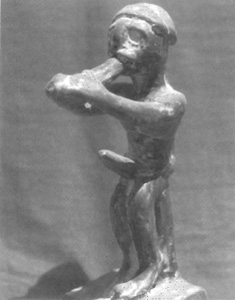
Italy: Flute player sporting a phallus. Bronze. Museum of Rome.
"Pan, with his enormous sexual organ, is the Priapus of Roman poets" (Payne Knight, The Worship of Priapus).
"Shiva travels in the forests and the jungles. He is called Pashupati, lord of the wild beasts" (Shatapatha Brāhmana, XII, 7.3.20).
Shiva's flock was composed of all living beings, including man. The only difference between animals, men, and gods is the role they play and their level in a continuous hierarchy. In all forms of existence, on various levels, the different aspects of the individual are present. There is no god without animality. no animal without humanity, no man without a portion of divinity.
"Dionysus was not a man; he was an animal and at the same time a god, thereby embodying the terminal points of the oppositions that man bears within himself" (Giorgio Colli, La Sapienza Greca, p. 15).
In every man can be distinguished three components called pati, pashu, and pāsha. Those in whom the element pati (master) dominates are the sages, kindred of the gods, who understand the rules of the divine game—creation—and participate therein. The majority of mankind in whom the animal element predominates are called pāshu (livestock). An abstract element, pāsha (the bond or snard, expresses the unity and interdependence of all life forms. Pāsha, the snare, represents the group of laws that hold together the different elements of matter and the living being trapped in that creation.
No other morality exists outside of respect for the pāsha, the bond—that is, the interdependence of the animal and the divine within ourselves, the realization of the place we occupy in the whole of the divine opus, the affinities that bind us to the animal and plant species, and the responsibilities that those relationships entail. Pasha could be defined as natural law, which is to say divine law. A type of behavior that is not founded on respect for nature and pāsha, the pact that joins together man and the divine, has nothing in common with true religion. Any other moral code is nothing but a social convention that is valueless on the universal level. True morality consists in conforming to those fundamental laws on which creation is founded. Everywhere that the influence of the cult of Shiva has extended, we rediscover the importance of the animal and the plant kingdoms. This aspect of religious history seems to have often escaped the notice of modern specialists on the ancient world.
India: Wood sculpture from Temple Ratha of peacock worshiping Shiva lingam, early nineteenth century Photograph by Lance Dane.
India: Pashupati, lord of animals. Seal of Mohenjo Daro, circa 2500 B.C. With permission of the National Museum of New Delhi.
"One of the most obvious aspects of Greek culture—the role played by plants and animals in myth and legend—remains unexplained" (R. E Willetts, Cretan Cults and Festivals, p. 60).
"Shiva looks at the gods and says to them: 'I am the lord of the animals.' The courageous Titans, the Asura, can be destroyed only if each of the gods and other beings assume their animal nature. The gods are hesitant to recognize their animal aspect. Shiva tells them: 'It is not degenerate to recognize one's animal' (the species in the animal kingdom corresponding to the principle that each god incarnates on the universal plane). Only those who practice the rites of the brothers to beasts, the pashupāta, can surpass their animal nature. It was thus that all the gods and the Titans recognized that they were the livestock of the Lord and that he was known under the name of Pashupati, the lord of the animals" (Shiva Purāna, Rudra Samhitā, 5.9.13–2 D.
To watch over the beasts and plants as well as men, Shiva created the vidyeshvara (masters of knowledge), who appeared as forest spirits, satyrs, nymphs, fairies, and guardian angels. These are creation's guardian spirits. Pashupati is the chief of these spirits, and through them manifests in every aspect of the natural world. Shiva dwells in the mountains and the forests; there his mysterious presence is felt, and it is there, within caverns or isolated locales, that shrines are built to him and offerings brought.
Very close to Shiva in symbolism and legend, Dionysus is the god of vegetation, vines, wine, fruits, and seasonal renewal. As principle and master of animal and human fertility, he is embodied in the form of the bull, the serpent, and the lion, who appear often in his legends and his cult. He is called Phallen or Phallenos.
By an interesting reversal occurring in mythical narratives, it is Dionysus who conquers India, teaching viniculture, establishing laws, and founding cities. In fact, the original habitat of the grape vine is India—the only region where it is naturally found in the wild.
The procession of the phallus plays an important role in his festivals. In the house of the Mysteries at Pompeii, we can see that the unveiling of the phallus was a part of Dionysian initiation rites.
"The sinuous serpent winding round the caduceus is once more in accordance with Celtic tradition. Again the horned god appears as a kind of native Silvanus, god of the woods, naked and without attribute apart from his huge penis. In north Britain another type of naked phallic god is figured, but without the horns, therefore presumably of the Cerne giant type, bearing arms or without attribute. A deity of similar type, fierce and aggressively phallic, comes from Maastricht, Holland. ...The combination of horned beasts, ithyphallic men and other symbols, together with the close association of a spring and probably a pool, indicate an ancient Caucasian fertility rite, somewhere between 1000 and 600 B.C." (Anne Ross, in Primitive Erotic Art, pp. 84–85).
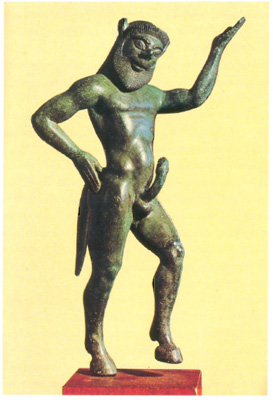
Italy: Etruscan ithyphallic satyr. Bronze. National Museum, Athens.
The character of Shiva in his aspect of animal charmer and guardian has often been transferred to later divinities such as Gopāla-Krishna, Pan, Orpheus, and even Jesus, the Good Shepherd.
"All the deities are called pashupāta (brothers of the beasts), because they form part of Pashupati's flock. All who consider the lord of the animals as their deity become beast brothers" (Linga Purāna, 80.56–57). They are then integrated into the flock of the god and capable of receiving his teachings.
"Shiva says: the very holy pashupāta yoga, the yoga of the beast brothers (by which the unity of all living beings can be realized) and the Sāmkhya cosmology (which explains the structure of the world), have been taught by me.... Knowing that the things of this world are ephemeral, it is necessary to continually practice the yoga of the animal lord" (Linga Purtina, 34.11–23).
THE GOD OF VEGETATION AND FERTILITY
In the Mediterranean tradition, the god Fascinus, who germinates plants and renders sterile women fertile, is personified by the phallus.
Priapus is the god of gardens and generation.
"During the course of certain Athenian festivals, women planted male sex organs as if they were sowing seed to ensure the fertility of the fields" (John Boardman and Eugenio La Rocca, Eros en Grecia, p.40).
The modern concept of ecology can be seen as a tentative return to a true morality, even though it is often anthropocentric. It is not solely a question of preserving nature for man's use but rather of rediscovering man's proper role within nature, as a cooperative agent in the work of the gods. A religion that does not respect the indivisible whole of creation and that is not fundamentally ecological is nothing but a deception, an excuse for human depredations that in no case can proclaim any divine origins. Man is only one element of a group, and it is the entire group that is the work of God.
At times the phallic image has a fertilizing power. Daphne was born from a phallic column. Jeremiah invoked those who spoke to the stone: "You have fathered me" (Jeremiah 2:27).
According to Prometheus' history of Italy in the Etruscan language cited by Plutarch, a phallus appeared in the chimney of the king of Albe. He ordered his daughter to couple with this phallus, but she refused and sent her servant instead. From the servant were born Romulus and Remus, who were abandoned in the forest and suckled by a wolf
The women of Veliae, in a prenuptial rite, had to couple with a phallus. This custom, also widespread among the Romans and described by early Christian writers such as Lactance and Arnobus, is represented on a bas-relief in the secret museum of Pompei. The fiancee offered her virginity to the god in order to win his favors and to avoid sterility.
Even today, the young girls of Nepal have their hymens broken by means of a phallus-shaped fruit in a rite that grants to the god a sort of "droit du seigneur."
In various cultures where the rites of phallus worship have officially disappeared, numerous phallic images can be found whose presence is regarded as essential to insure the fertility of women and fields alike. This is the case in all of eastern Africa, in particular among the Yoruba. One often comes across those phallus-shaped altars that insure the fertility of the earth and to which are made offerings of sperm at the on set of the sowing season.
Analogous rites and images have existed until very recent times in the entire area of Oceania. Numerous images of an ithyphallic god are gathered in the museums of California.
Further on in this work we will investigate the fertilizing role of Santo Membro in medieval Europe, a role that has survived to the present day in central Italy.
"The belief in the fertilizing virtues of menhirs was still shared by European peasantry at the beginning of the century. In France, young women who desired to have children were in the habit of sliding down these stones or creating a similar friction by sitting atop the monoliths or rubbing their bellies against them" (Mircea Eliade, Histoire des croyances et des idùes religieuse, 1.130).

Indonesia: Wood sculpture representing an ithyphallic fertility god.
THE SPIRIT OF THE FORESTS, THE LEWD AND NAKED GOD
The gods and the prophets have been created naked. Every human being is created nude" (Linga Purāna, 1.34.13).
Nudity represents a return to the primordial state. The identification of man and god with nature implies nudity. David danced naked in front of the ark (2 Samuel 6:14). The true man is nude; it is the hypocritical and pharisaic religion of the cities that demands clothing. Shiva is naked, "clothed in space." The sage and the Shaivite monk wander the world naked and without attachments. Nudity is synonymous with liberty, virtue, truth, and holiness. The ancient atheist religion of India, Jainism, the rival of Shaivism in other regards, made similar demands of its faithful that they be naked. The Greek world was very familiar with its gymnosophists, naked ascetics who came from India, and the soldiers of Alexander who wished to follow the teachings of Indian philosophers had to disrobe. Nudity has a sacred and magic value. "To sow your seed go naked, strip to plow and strip to reap, if you would harvest all Demeter's yield in season. Thus each crop will come in turn" (Hesiod, Works and Days, p. 390–95).
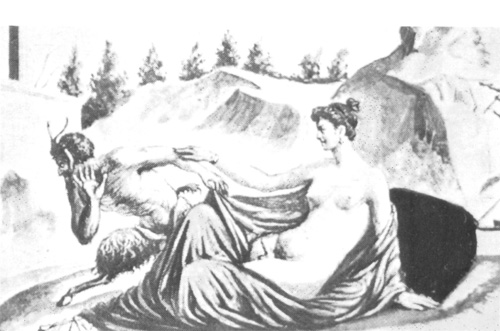
Italy: Fresco reproduction of Hermaphrodite and the god Pan, early nineteenth century. Pompeii. From the private collection of Emde Boas. Photograph from Rufus Camphausen's Encyclopedia ofErotic Wisdom (Inner Traditions).
Ritual nudity is well known and widespread in ancient religions. Shinto priests purify themselves in nakedness, and it was in nakedness that Hebrew priests penetrated the Holy of Holies to signify their lack of ornamentation at the approach of the divine mystery. There are countless examples in Celtic literature where masculine nudity is closely connected with the warrior's trance. Celtic warriors went into combat naked. In the Irish mythological tale The Destruction of Da Derga's Hostel, the bird-father of the king says to him: "A man stark-naked, who shall go at the end of the night along one of the roads of Tara, having a sling and a stone, he shall be king" (Anne Ross, in Primitive Erotic Art p. 81).
Dionysus himself is also represented as a long-haired nude when he is not clothed in a saffron-colored monk's robe.
India: Shiva as youth with elongated phallus. Photograph by Lance Dane.
The legends of the Purānas depict Shiva as a lewd adolescent who roams naked in the forest, charming the women of the prideful ascetics who wish to conquer heaven by the force of their will. Shiva humiliates the ascetics, seduces their wives, and through spilling his semen here and there causes the earthly appearance of precious stones and sacred sites.
According to the Shiva Purāna (Kothi Rudra Samhitā, chapter 12), "There existed a large cedar forest called Dāruvana. A large number of hermit worshipers of Shiva lived there, ceaselessly meditating on the creator of the world. Three times a day they performed ritual prayers to their lord and sang hymns to his glory. One day while the hermits were off in the forest seeking the sacred herbs they used in their rites, Shiva, to test their faith, embodied himself in a strange form. He appeared resplendent and totally naked. His body was coated in ashes with no other ornamentation. He stood there with his penis in his hand and started making an exhibition of himself with obscene acts. Shiva had come to this place to display the benevolence he felt toward his faithful who were the inhabitants of this forest.
"The lord had the appearance of a man of low estate. In his hand a flaming torch shook. His eyes were red and brown. Sometimes he would laugh uproariously; sometimes he would sing in an astonishing manner. Sometimes he danced lasciviously; sometimes he cried out. He wandered around the hermitages like a beggar.... Despite his dark-colored skin, he was of a surprising beauty. He laughed and sang, winking at the women in such a way that they were utterly captivated. He, who had vanquished the god of love, inspired desire by his beauty alone. Despite his strange appearance and his tanned skin, the most chaste women were attracted to him" (Linga Purāna, 1.29.7, 10, 12, and 1.31.28–32).
"The wives of the hermits were frightened at first sight. Despite their surprise, many felt drawn to the god and approached him. Some sought to embrace him, others to seize hold of his hands. They began to fight among themselves for the privilege of touching him" (Shiva Purāna, Kothi Rudra Samhitā, 12.9).
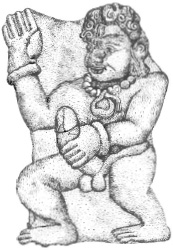
India: Mukteshvara Temple, Bhuvaneshvar. Ithyphallic dwarf, twelfth century.
"At a smile on his lips, those women before their huts and those living in the treetops dropped their work. They tore off their clothes and let their hair down. Some even rolled in the dirt. They clutched at one another and, blocking the god's path, made lewd gestures to him in the absence of their husbands. The lord said nothing to them, neither good nor evil" (Linga Purāna, 1.29.7–9). Here can be seen another version of the conduct of the maenads, and the name given to Dionysus: Gynaimanes (he who drives women mad).
"It is at this moment that the sages returned. Seeing this naked man giving free rein to obscene acts, they were scandalized and entered in a rage. Deceived by Shiva's power of illusion and blinded by their prejudice, they cried out: 'What's going on here? What is the meaning of this? Say, who is this? Say, who is this?' But the naked figure made no response to their queries" (Shiva Purāna, Kothi Rudra Samhitā, 12.14).
"The priests and sages gave utterance to words of indignation, but the power of their virtues was ineffective against Shiva, in the same way that the glow of the stars can do nothing against the light of the sun" (Linga Purāna, 1.29.9,24).
"The sages cried out: 'This Shiva who carries a trident has an ill-omened body. Has he no shame? He has no dwelling nor any known ancestors. He is naked and poorly formed. He lives in the company of bad and evil spirits.... If he had any money he wouldn't be running around naked. He goes about on a bull; he has no other carriage. His caste is unknown; he is neither learned nor wise. He has none in his retinue but evil spirits. He is up to his neck in poison. Compare your necklaces to the garland of skulls he wears, your cosmetics to the ashes from funeral pyres with which he covers his body'" (Shiva Purāna, Rudra Samhitā, 24.45–47 and 27.36).
"When the naked figure didn't respond, the hermits hurled even greater imprecations against the terrible man-god: 'You comport yourself in an indecent manner. You have violated the rules of the Veda. May your penis fall to the ground!' The moment these words were uttered, the penis of the divine envoy, who was none other than Shiva of the splendid body, fell to the ground. But it burned everything in its path. Everywhere it went, everything caught fire and was burnt. It descended into the depths of the infernos; it rose into the very heavens; it ravaged the entire earth. No spot remained unpenetrated by it. All worlds and beings were in great distress. The hermits were terrified. No longer could either gods or wise men experience any peace or joy. Finally Shiva vanished.
"The gods and the hermits who hadn't known enough to recognize him were full of consternation. They gathered together and went to the maker of the world, the god Brahmā, to implore him for protection. After singing his praises, they recounted to him everything that had occurred. Brahmā said to them: 'How stupid you are! In one moment you have destroyed all the credits you acquired by your practice of abstinence. That man with the erect penis that you have seen—impotents that you are—is the Supreme Lord in person' " (Linga Purāna, 1.29.9–25).
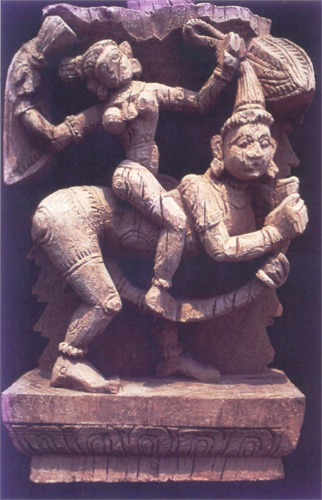
India: Shiva mounted by female who uses his elongated phallus as a bridle. Photograph by Lance Dane.
"'How is it possible that you, who are wise, could commit such errors? How can you condemn the poor ignoramus for his faults when you behave just like him? Who then could expect to recover their serenity after having offended Shiva so gravely? When someone refuses to honor an unforeseen guest who appears at his door at mealtime, all credit earned by one's practice of abstinence is carried away by the visitor, who leaves in return the weight of all his misdeeds. What can happen when that visitor is Shiva himself? As long as the sex organ of the god remains unstabilized, nothing good can occur in any of the three worlds. Such is the truth.
"To calm his rage, you must erect a stone phallus and water this divine sex organ with holy water. You must construct a pedestal fur it in the form of a vagina and an arrow [symbol of the goddess] and install it with prayers, offerings, acts of self-abasement, hymns, and songs accompanied by musical instruments. Then you must call forth the god by saying: "You are the source of the universe, the origin of the universe. You are present in all that exists. O Benevolent One! Calm down and protect the world." 'The sages then piously approached Shiva, who said to them: The world will not find peace until my penis has found a receptacle. No other than the Lady of the mountain can lay hold of my penis. If she grasps it, it will calm down immediately' " (Shiva Purāna, Kothi Rudra Samhitā, 12.22–46).
CASTRATION
The emasculation of the masculine sky related by Hesiod is tied to the same symbolism. According to the Theogony (188 ff.), Aphrodite was born from the sex organ of Ouranos, which had been thrown into the sea and surrounded by a white foam that evoked the semen of the emasculated heavens. Aphrodite means "foam."
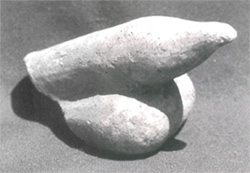
Italy: Sculpture of severed phallus, first century. Rome. Collection of Jacques Cloarec.
"The castration of Ouranos puts an end to a period of uninterrupted procreation, evoking the tendency of the gods to withdraw after having completed their cosmogonical work. In Hurrute and Hittite theogony, Kumarbi, the father of the gods, pursued Anu, and seizing him by the feet, flung him to the ground after having bitten off his penis. A fraction of Anu's virility penetrated his body, and he became pregnant with three gods" (Mircea Eliade, Histoire des croyances et des idées religieuses, pp. 150 and 159).
In Egypt, the broken and truncated body of the agrarian deity Osiris, murdered by his brother Seth and thrown into the Nile, was reassembled anew by Isis, except for his penis, which had been eaten by a fish.
In Greece, the young and beautiful Phrygian shepherd Attis, the lover of Rhea, was mutilated during a burst of insanity. His faithful practiced orgiastic celebrations and, in an extreme ritual, cut off and deposited their virile organs on the altars of Attis and Rhea. A similar practice exists as well in India, among the impassioned worshipers of the goddess Kālī.

